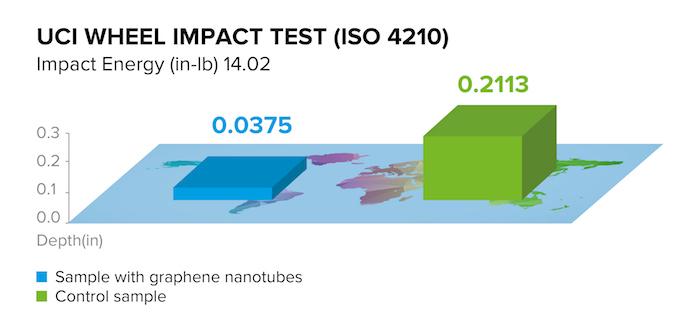
“One of the most important characteristics for bicycle rims is impact resistance. In recent tests of TUBALL graphene nanotubes, we have shown that we can improve this by more than 15% by evenly dispersing just 0.05% of nanotubes in the resin of the composite material,” commented Jim Chin I Lin, General Manager of Zhongshan A&E Machinery Industry, a spin-off of Hodaka Technology. “And by adding just 0.2% by weight of nanotubes, the shear strength and flexural (bending) strength of composite materials can be increased by 30% and 9% respectively.” These initial findings show great potential for developing high-performance lighter bicycle rims with graphene nanotubes.
But what are graphene nanotubes, and how do they lead to such strong improvements? Think of a single-atom-thick graphene sheet rolled into a tube. Graphene nanotubes are superstrong but at the same time flexible, and are one of the best electrical conductors ever to be discovered. Understanding how to get these astonishing properties into composites provides opportunities to realise the most ambitious technologies. “The key challenge with nanomaterials is how to introduce and properly disperse them throughout the material matrix. This technology still needs some improvement and further development, but we are on the right track,” added Mr Lin.
Graphene nanotubes bond the resin and fiber together, resulting in a stronger and more uniform composite material. When the material undergoes an impact, the nanoparticles produce a stress concentration effect and absorb the impact energy. “We have performed the UCS wheel impact test (ISO 4210) for a road clincher composite rim reinforced by nanotubes. We were really impressed with the results – almost 100% enhancement in comparison with the standard bicycle rim,” said Mr Lin.

Graphene nanotubes are destined to spread not only into tech-intensive sectors, but also to mass market products. Because, in contrast to graphene sheets, they are already being produced on an industrial scale, by OCSiAl, and at a market-competitive price. Nanotube-reinforced rims demonstrate very promising potential to outperform today’s rims in characteristics such as impact resistance, durability and weight reduction. “The fact that riders can benefit greatly from graphene nanotube-enhanced bicycles is what determines our strategy,” concluded Mr Lin.
